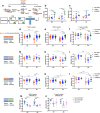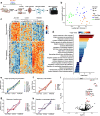Dietary Fiber and Microbiota Metabolite Receptors Enhance Cognition and Alleviate Disease in the 5xFAD Mouse Model of Alzheimer's Disease
- PMID: 37596052
- PMCID: PMC10506626
- DOI: 10.1523/JNEUROSCI.0724-23.2023
Dietary Fiber and Microbiota Metabolite Receptors Enhance Cognition and Alleviate Disease in the 5xFAD Mouse Model of Alzheimer's Disease
Abstract
Alzheimer's disease (AD) is a neurodegenerative disorder with poorly understood etiology. AD has several similarities with other "Western lifestyle" inflammatory diseases, where the gut microbiome and immune pathways have been associated. Previously, we and others have noted the involvement of metabolite-sensing GPCRs and their ligands, short-chain fatty acids (SCFAs), in protection of numerous Western diseases in mouse models, such as Type I diabetes and hypertension. Depletion of GPR43, GPR41, or GPR109A accelerates disease, whereas high SCFA yielding diets protect in mouse models. Here, we extended the concept that metabolite-sensing receptors and SCFAs may be a more common protective mechanism against Western diseases by studying their role in AD pathogenesis in the 5xFAD mouse model. Both male and female mice were included. Depletion of GPR41 and GPR43 accelerated cognitive decline and impaired adult hippocampal neurogenesis in 5xFAD and WT mice. Lack of fiber/SCFAs accelerated a memory deficit, whereas diets supplemented with high acetate and butyrate (HAMSAB) delayed cognitive decline in 5xFAD mice. Fiber intake impacted on microglial morphology in WT mice and microglial clustering phenotype in 5xFAD mice. Lack of fiber impaired adult hippocampal neurogenesis in both W and AD mice. Finally, maternal dietary fiber intake significantly affects offspring's cognitive functions in 5xFAD mice and microglial transcriptome in both WT and 5xFAD mice, suggesting that SCFAs may exert their effect during pregnancy and lactation. Together, metabolite-sensing GPCRs and SCFAs are essential for protection against AD, and reveal a new strategy for disease prevention.Significance Statement Alzheimer's disease (AD) is one of the most common neurodegenerative diseases; currently, there is no cure for AD. In our study, short-chain fatty acids and metabolite receptors play an important role in cognitive function and pathology in AD mouse model as well as in WT mice. SCFAs also impact on microglia transcriptome, and immune cell recruitment. Out study indicates the potential of specialized diets (supplemented with high acetate and butyrate) releasing high amounts of SCFAs to protect against disease.
Keywords: Alzheimer’s disease; dietary fiber; metabolite-sensing GPCRs.
Copyright © 2023 the authors.
Figures





References
Publication types
MeSH terms
Substances
LinkOut - more resources
Full Text Sources
Medical
Molecular Biology Databases
